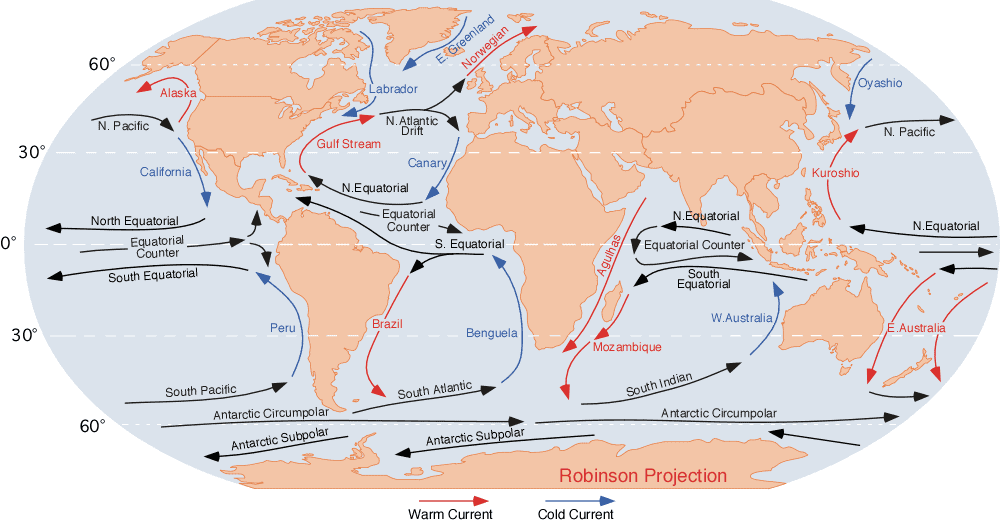
Global Weather and Climate
Because the ocean absorbs most of the solar radiation that reaches Earth, the interaction between the ocean and atmosphere controls the weather and climate. Changes in the ocean or atmosphere can result in changes to the climate.
The sun’s energy warms our world, and the ocean takes up most of that solar radiation (heat). The reason why is complex, but we can simplify it with three main points.
Firstly, the ocean can absorb massive amounts of energy without changing its temperature too much. This is because water has a high heat capacity. This means it would take a great deal of energy to raise one litre of water by one degree Celsius.
The ocean has a very large volume so it can absorb a lot of the heat without reaching it’s heat capacity.
The ocean covers approximately 70% of the Earth’s surface so it has a lot of surface area to absorb the solar radiation.

The sun heats the planet unevenly which creates regional and seasonal differences in temperature and pressure. These differences, with the Earth’s rotation and convection (cold air sinking and warm air rising), results in air moving.
Winds help move the ocean surface currents which makes climates in northern regions like Europe warmer and easier to inhabit.
On the other hand, the colder and saltier water, which is denser, creates slower and deep currents in the ocean. Ocean circulation or currents move water and heat around the planet, warming cool areas and cooling warm areas.
The ocean has so much control over the weather and climate, we might even call the ocean our ‘air conditioner’ as it regulates and moderates atmospheric temperature.

The ocean also conditions the air by absorbing excess carbon dioxide (CO2). It absorbed about 40% of CO2 burned since the start of the Industrial Revolution in 1775. The increased amounts of atmospheric CO2 from burning fossil fuels results in big changes in climate and ocean systems, even changing ocean chemistry.
Now the ocean can only take up about one third (33%) of our CO2 emissions annually and it warms. As it gets warmer it can take less and less CO2. With less CO2 being taken into the ocean, more carbon dioxide coats the atmosphere like a warm blanket, trapping heat and insulate the planet.
Long-term warming is only one sign of climate change but it has a big impact that is slowly raising ocean temperatures, increasing storm intensities, melting ice, raising sea levels, and changing salinity regimes.
By knowing the properties of water and how heat is absorbed or released through the different states of H2O, we can better understand climate and ocean change. The exchange of heat between atmosphere and ocean drives the water cycle, some winds, and ocean currents. It also influences weather.

Hurricanes and cyclones, for example, are driven by heat exchange from ocean to atmosphere and back again.
Most rain that falls on land came from water evaporated from the ocean and global patterns of rain and drought, as well as major weather phenomena, can be traced to ocean currents and sea surface temperatures.
Ocean circulation redistributes heat and moisture in the atmosphere. Feedback loops that connect ocean, atmosphere, weather, and climate can have unexpected consequences.
One of the most important examples of oceanic influence over weather is El Niño – Southern Oscillation (ENSO) and La Nina. We hear these terms often on the news or weather channels. ENSO is an irregular occasional change in winds and sea surface temperature.
This change is a climate occurrence and shifts between either neutral, La Niña, or El Niño. It usually occurs over the Eastern Pacific Ocean and it’s affects stretch all across the globe.
El Niño is a warming phase with high surface air pressure. La Niña is a cooling phase with low air surface pressure. The effects of El Niño and La Niña are felt across the globe.
During a La Niña phase (cooling), we can expect heavy rains across Southeast Asia, it can also lead to drier than normal conditions in the north across Alaska. La Niña shifts storm tracks far enough northward to bring wetter than normal winter conditions to Midwestern States as well as hot and dry summers.
In an El Niño phase (warming), one can expect warm and very wet months during April to October which can cause major flooding in South America.
It is also likely to cause heavy rain in Western North America. It increases the risk of tropical storms, cyclones, and hurricanes because it is a warmer than usual climate change.
Over the last few years the number of El Niño events have increased and the number of La Niña events have decreased. More observation time is needed before robust changes can be detected; however, many scientists believe that El Niño is linked to the global climate change that is seeing an increasing warming of the planet.
The more we know about how we influence these big processes like weather, climate, and ocean, the more we can take responsibility for its health. We can create solutions that protect people, places, and life-giving habitats. Solutions, such as reducing our carbon footprint, is a good place to start.
With this knowledge, humans can work together to achieve the United Nations Sustainability Goals. With our understanding of the ocean, we can work towards the goals:
14.2 By 2020, sustainably manage and protect marine and coastal ecosystems to avoid significant adverse impacts, including by strengthening their resilience, and take action for their restoration in order to achieve healthy and productive oceans
14.5 By 2020, conserve at least 10 per cent of coastal and marine areas, consistent with national and international law and based on the best available scientific information
14.C Enhance the conservation and sustainable use of oceans and their resources by implementing international law as reflected in UNCLOS, which provides the legal framework for the conservation and sustainable use of oceans and their resources, as recalled in paragraph 158 of The Future We Want
Posted January 17, 2022 by Rosemary Newton








